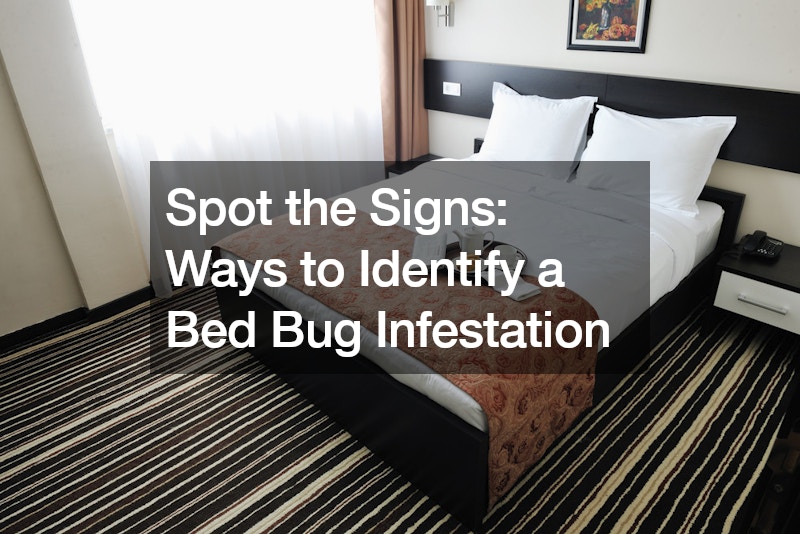Bed bugs are notorious pests, often found in densely populated areas like urban centers, where they thrive in the warmth and proximity of human habitation. Identifying a bed bug infestation early is crucial for effective eradication. These tiny bloodsuckers can be challenging to detect, but there are several telltale signs to watch out for.
Bites: One of the most common signs of a bed bug infestation is waking up to itchy bug bites on your body. These bites typically appear in clusters or zigzag lines and are commonly found on areas of the body where bare skin is exposed during sleep, such as the arms, hands, and legs.
However, it’s essential to note that bed bug bites can be mistaken for other insect bites, such as those from mosquitoes or fleas.
Musty Odors: Another indicator of a bed bug infestation is an unusual musty odor in the bedroom. This odor is caused by a combination of factors, including dead bed bugs, pheromones, and fecal matter. Some describe the smell as reminiscent of rust, wet towels, or moldy laundry. While initially faint, this odor intensifies as the infestation grows.
Bloodstains: Bed bugs feed on blood, and if you disturb them while they are feeding, you may crush them, leaving behind small blood stains on your sheets. These stains may appear as small, rust-colored spots and are often a sign that bed bugs are present.
Fecal Marks: Bed bug feces are small, dark brown or black spots resembling ink dots. These marks can be found on sheets, mattresses, headboards, and other surfaces where bed bugs hide. Unlike bloodstains, fecal marks are usually smaller and darker and may smear when exposed to water.
Shell Casings: Bed bugs shed their exoskeletons as they grow, leaving behind translucent husks known as shell casings. These casings are often found along mattress seams and in other areas where bed bugs congregate. They are yellowish or tan in color and roughly the shape of a small bed bug.
Bed Bug Eggs: Female bed bugs lay eggs in crevices around their harborage areas. These eggs are about one millimeter long, pearly white in color, and oval-shaped, resembling tiny grains of rice. Unhatched eggs are smooth on the surface and filled with liquid, while hatched eggs may feel dry or wrinkled.
Live Bed Bugs: The most convincing sign of a bed bug infestation is the presence of live bed bugs. These insects are flat, oval-shaped, and brown or reddish-brown in color, with a large rounded abdomen, two short antennae, and six thin legs. They are typically the size of a flaxseed or a small apple seed.
Identifying these signs early can help homeowners take prompt action to address a bed bug infestation. While some may attempt DIY solutions, it’s often best to seek professional pest control services for effective eradication. Pest control prices may vary depending on the severity of the infestation and the size of the property.
Here are some additional tips for preventing bed bug infestations:
- Be cautious when traveling. Bed bugs are excellent hitchhikers and can easily travel from place to place in luggage or on clothing. After staying in a hotel, thoroughly inspect your luggage and belongings for signs of bed bugs before bringing them home.
- Inspect secondhand furniture carefully. Bed bugs can hide in cracks and crevices of used furniture. Before bringing any secondhand furniture into your home, inspect it thoroughly for signs of bed bugs, including live insects, shed skins, or fecal spotting.
- Vacuum regularly. Vacuuming carpets, rugs, and upholstered furniture regularly can help remove bed bugs and their eggs. Be sure to pay close attention to areas where bed bugs are likely to hide, such as along mattress seams, baseboards, and furniture cracks. After vacuuming, dispose of the vacuum bag immediately in an outdoor sealed trash bin.
- Use mattress encasements. Encase your mattress and box spring in specially designed, tightly woven covers that trap bed bugs inside. These encasements can help prevent bed bugs from feeding on you and can also help to kill any existing bed bugs that are trapped inside.
- Declutter your home. The fewer places bed bugs have to hide, the easier it will be to control an infestation. Get rid of clutter around your bed and in other areas where bed bugs might be present. This includes removing piles of clothes, shoes, and other belongings from the floor.
- Wash linens in hot water. Regularly wash your sheets, pillowcases, and blankets in hot water (at least 130 degrees Fahrenheit) to kill bed bugs and their eggs. Dry your laundry on high heat for at least 30 minutes to ensure all bed bugs are eliminated.
- Be vigilant. Early detection is key to successfully eliminating a bed bug infestation. Regularly inspect your mattress, box spring, and surrounding areas for signs of bed bugs, such as live insects, shed skins, fecal spotting, or bloodstains.
By following these tips and being aware of the signs of a bed bug infestation, you can take control of the situation and prevent these pests from taking over your home. Remember, a proactive approach is essential. If you suspect a bed bug problem, don’t hesitate to contact a qualified pest control professional for assistance. Their expertise and experience can help you eliminate the infestation quickly and effectively, saving you time, money, and frustration in the long run.
.


